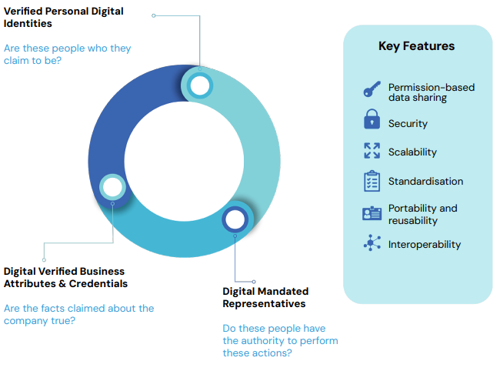Is 2025 the Year of Digital ID in the UK?
The UK is a market often noted for its resistance to digital ID or national identity systems in general. It is often believed that the UK public are less open to the idea than citizens of other countries and prioritise privacy over the efficiency gains a digital ID system could offer. However, this is slowly changing, as indicated by a YouGov poll in December 2024 which found strong support for a system of national identity cards in the UK.
Question: Would you support or oppose the introduction of a
system of national identity cards in Britain?

Source: YouGov
Another significant movement in December 2024 occurred with the unveiling of new proposed legislation that, if passed, would enable UK residents to use digital IDs to verify their age when buying alcohol. This will be applicable in pubs, clubs, and shops. The IDs will be provided by third-party companies and checked against government records, with these checks carried out by either NFC or QR codes, ensuring the process is streamlined. These digital IDs will also not reveal the user’s name or address, as is the case with traditional IDs.
These changes will come from the Data (Use and Access) Bill, introduced to Parliament in 2024. The bill is currently in the House of Lords, with it still needing to pass the House of Commons and gain Royal Assent before it becomes law. In its press release, the Department for Science, Innovation and Technology state they expect it to be in force by the end of 2025.
This follows on from the 2023 decision, by the previous government, to allow UK citizens to upload identity documents to apps in order to carry out Disclosure and Barring Service (DBS), right to work, and right to rent checks. These services are provided by third-party identity services, such as Yoti, and it is expected that the same companies will be involved in the provision of the new digital IDs.

Source: Yoti
It is worth stressing that this will be a fairly limited programme, with participation entirely optional for both consumers and businesses. This will likely result in slow and uneven adoption, as was seen with the 2023 roll-out of digital IDs, with the vast majority of locations which accepted these IDs being in London or other major cities. This is due to the fact that consumers are unlikely to adopt the technology unless it is usable in a good number of the locations they use. Equally, businesses are less likely to adopt it if consumers are not using it. This results in the market for these technologies taking longer to reach critical mass and become widespread.
It is not only in the consumer sector that digital identity is growing in the UK. In December 2024, a coalition of leading financial institutions and technology companies, led by the UK’s Centre for Finance and Innovation Technology (CFIT), unveiled their progress on designing a digital company ID.
Proposed Components of 'Digital Company ID'

Source: CFIT
The proposed model would enable CFIT to create a working prototype, in the form of a virtual passport for businesses. CFIT suggest that the widespread adoption of a digital company ID would help prevent fraud, boost efficiencies for banks and other financial institutions. This work was supported by the Chancellor, in the National Payments Vision published in November 2024, with the document pledging to ‘consider any finding that emerge from CFIT’s work in due course’. CFIT will announce the results, recommendations and next steps from its programme in March 2025.
The adoption of digital IDs for businesses would reduce fraud as it is more challenging to fake a digital identity. This would give businesses the confidence that those they transfer money to are who they claim to be. The IDs would also be used for Know Your Business (KYB) checks, along with ultimate beneficial owners (UBO) checks and comparison to anti-money laundering (AML) databases. If implemented well, this technology could not just reduce financial crime but also allow businesses to save costs on carrying out these checks by conventional methods. Adoption in the financial sector is likely to be strong if made available, as several major FIs are already involved in the project. Regulatory support is also likely as the Financial Conduct Authority (FCA) and the Payment Systems Regulator (PSR) are both involved.
With both these announcements coming at the end of 2024, 2025 is shaping up to be a big year for digital identity in the UK. While it seems unlikely there will be widespread adoption of a digital ID in the UK by consumers before the end of 2025, the foundations for such a success story are being laid. If the Government wants this to happen, targeting key use cases will be essential. Common points of friction for consumers, such as age verification at self-service checkouts, or entry to licensed premises, will play an important role in promoting adoption. It is usual for consumers to have their mobile device on them in such circumstances, so as such, having their ID on that device offers great convenience. It will be the convenience of use and acceptance rate by businesses which ultimately will determine the success of the technology.
A Senior Research Analyst at Juniper Research, Michael primarily conducts research on digital identity and payments markets. His recent reports include Digital Identity, Instant Payments, and Digital Wallets.
Latest research, whitepapers & press releases
-
 ReportDecember 2025
ReportDecember 2025AI Agents for Customer Experience Platforms Market: 2025-2030
Our comprehensive AI Agents for Customer Experience Platforms research suite comprises detailed assessment of a market that is set to disrupt mobile communications. It provides stakeholders with insight into the key opportunities within the AI agents for customer experience platforms market over the next two years.
VIEW -
 ReportDecember 2025Fintech & Payments
ReportDecember 2025Fintech & PaymentseCommerce Fraud Prevention Market: 2025-2030
Our eCommerce Fraud Prevention research suite provides a detailed and insightful analysis of this evolving market; enabling stakeholders from financial institutions, law enforcement agencies, regulatory bodies and technology vendors to understand future growth, key trends, and the competitive environment.
VIEW -
 ReportNovember 2025Telecoms & Connectivity
ReportNovember 2025Telecoms & ConnectivityeSIMs & iSIMs Market: 2025-2030
Juniper Research’s eSIMs and iSIMs research suite offers insightful analysis of a market set to experience significant growth in the next five years. The research suite provides mobile network operators (MNOs), original equipment manufacturers (OEMs), and eSIM management and platforms vendors with intelligence on how to capitalise on the market growth, and guidance on how eSIM-only devices and sensors, SGP.42, in-factory provisioning, and iSIMs will change the competitive landscape.
VIEW -
 ReportNovember 2025Fintech & Payments
ReportNovember 2025Fintech & PaymentsModern Card Issuing Platforms Market: 2025-2030
Our Modern Card Issuing Platforms Market research suite provides a detailed and insightful analysis of this evolving market; enabling stakeholders from banks, financial institutions, fintech companies, and technology vendors to understand future growth, key trends, and the competitive environment.
VIEW -
 ReportNovember 2025Fintech & Payments
ReportNovember 2025Fintech & PaymentsDigital Wallets Market: 2025-2030
Our digital wallets research suite provides detailed analysis of this rapidly changing market; allowing digital wallet providers to gain an understanding of key payment trends and challenges, potential growth opportunities, and the competitive environment.
VIEW -
 ReportOctober 2025Fintech & Payments
ReportOctober 2025Fintech & PaymentsDigital Identity Market: 2025-2030
Juniper Research’s Digital Identity research suite provides a comprehensive and insightful analysis of this market; enabling stakeholders, including digital identity platform providers, digital identity verification providers, government agencies, banks, and many others, to understand future growth, key trends, and the competitive environment.
VIEW
-
 WhitepaperDecember 2025Telecoms & Connectivity
WhitepaperDecember 2025Telecoms & ConnectivityHuman + AI: Drivers of Customer Experience AI Agents in 2026
Our complimentary whitepaper, Human + AI: Drivers of Customer Experience AI Agents in 2026, examines the key drivers of the AI agents for customer experience platforms market in 2025.
VIEW -
 WhitepaperDecember 2025Fintech & Payments
WhitepaperDecember 2025Fintech & PaymentsBeyond Chargebacks: The True Cost of Fraud for Digital Commerce
Our complimentary whitepaper, Beyond Chargebacks: The True Cost of Fraud for Digital Commerce, examines the state of the eCommerce fraud prevention market; considering the impact of evolving digital fraud strategies, including key trends such as identity theft, account takeovers, chargebacks, policy abuse and friendly fraud.
VIEW -
 WhitepaperNovember 2025Telecoms & Connectivity
WhitepaperNovember 2025Telecoms & ConnectivityeSIM-only Devices: The Impact on Operators, Consumers, and IoT
Our complimentary whitepaper, eSIM-only Devices: The Impact on Operators, Consumers, and IoT, explores the challenges and opportunities for the three segments, with a particular focus on eSIM-only smartphones and SGP.42.
VIEW -
 WhitepaperNovember 2025Fintech & Payments
WhitepaperNovember 2025Fintech & PaymentsUnlocking the Next Stage of Growth for Modern Card Issuing Platforms
This free whitepaper analyses key trends shaping the modern card issuing space, and the ways in which modern card issuing platforms can capture growth.
VIEW -
 WhitepaperNovember 2025Fintech & Payments
WhitepaperNovember 2025Fintech & PaymentsTop 10 Fintech & Payments Trends 2026
Fintech is evolving fast. From stablecoins to agentic AI, our annual guide reveals the shifts redefining payments, digital identity, and the future of money in 2026. Download your copy today.
VIEW -
 WhitepaperNovember 2025Fintech & Payments
WhitepaperNovember 2025Fintech & PaymentsDigital Wallets: Empowering Financial Inclusivity
Our complimentary whitepaper, Digital Wallets: Empowering Financial Inclusivity, examines the state of the digital wallets market; considering the impact of digital wallets on different geographies, how they are shaping the modern payments landscape through lower transaction fees and promoting financial inclusivity for underbanked populations, and how they are competing with established payment methods.
VIEW
-
IoT & Emerging Technology
Juniper Research Unveils Top 10 Emerging Tech Trends to Watch in 2026
January 2026 -
Fintech & Payments
Digital Identity App Usage to Hit 6.2 Billion by 2030, Driven by Shift to Decentralised Models
December 2025 -
Telecoms & Connectivity
Travel eSIM Margins Under Pressure as Revenue per Gigabyte Falls 10% Globally in Two Years
December 2025 -
Telecoms & Connectivity
AI Agents to Power 1,000% More Customer Interactions for Enterprises Globally by 2027
December 2025 -
IoT & Emerging Technology
Global D2C Revenue Set for $370 Million Surge, But Satellite Operators Should Not Chase Full MNO Status
December 2025 -
Fintech & Payments
Digital Goods Fraud to Cost eCommerce Merchants $27 Billion Globally by 2030 as AI Tools Accelerate Attacks
December 2025

























